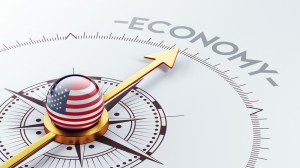The precarious road to economic recovery

 The economy is improving, but it is not improving as well as it could, said Tom Smythe, Ph.D., an associate professor of business and accounting at Furman University.
The economy is improving, but it is not improving as well as it could, said Tom Smythe, Ph.D., an associate professor of business and accounting at Furman University.
Smythe spoke Wednesday at High Noon at the Upcountry History Museum, a series of lectures sponsored by Furman. A 1985 Furman alumnus, he joined the university faculty in 2001 after stints in the U.S. Army as an engineer officer and Mobile Oil as a systems and business analyst.
Although many economic headlines say the economy is improving—and it is—the United States continues to see sluggish growth, he said.
“We are in recovery. The recovery we’re in is the slowest since the 1940s,” he said. The Great Recession from 2008 to 2010 destroyed eight million jobs. It took four years to add those jobs back, a level reached in the past month or so.
Why is the recovery so slow?
The answer: uncertainty. Businesses and consumers act slowly when they face uncertainty. Dr. Smythe said he expects sluggish growth for the next five to 10 years.
The major drags on the economy include fiscal policy, monetary policy, regulations on the banking industry, and the decision of U.S. firms to disinvest in the U.S. economy, he said.
When it comes to fiscal policy, “the reality is that our fiscal policy is grossly out of control,” he said. The country overspends, primarily on mandatory programs such as Social Security, Medicare, and debt interest.
Currently, about 55 percent to 60 percent of the budget is devoted to mandatory spending. That was 50 percent in 2000 and is projected to be 75 percent in 2014.
“Even if we balance the budget, we’re spending less and less and less on what we might argue the government should be doing,” he said.
According to the 2015 budget, Social Security expenditures are projected to increase by 5.8 percent while revenues will increase by 5 percent. The budget projects a growth in Medicare expenditures of 6.3 percent while revenues will be up by 5.3 percent. Interest on existing debt is expected to grow by 15 percent a year for the new 10 years.
That budget projects GDP growth of 4.7 percent annually during the next decade. Dr. Smythe said that during the past 35 years, GDP has been 4.7 percent or higher in two years. More likely growth is 3 percent to 3.5 percent.
While the government can cut expenses as an individual would, “the reality is there is a bare minimum that has to be provided.” That bare minimum will probably be hit soon, he said, and then choices—higher taxes or fewer services—must be made.
In addition, the debt ceiling debates—likely to reoccur in December or February in a contentious atmosphere—create as much uncertainty as excess spending does, he said. It is naïve to think that such fights don’t create economic uncertainty for businesses and individuals and other countries.
“We have to pay our debts,” he said. “If we don’t, it will be catastrophic.”
Another element of the uncertainty is the Affordable Care Act and its implementation. Regardless of the politics of the healthcare act, uncertainty is created during the phase-in of regulations over five years. “Every single year something changes” and usually that increases costs to businesses.
He expects monetary policy, however, to be the largest uncertainty facing the economy over the next year or two. While the Federal Reserve’s acted wisely in 2008, the resulting low interest rates are unsustainable. The low rates create market distortion because credit worthiness has not increased as much as rates would indicate. The question is how will the Fed manage to unwind its actions it took to protect the economy from collapse.
“The answer is we don’t know,” he said.
Banking regulations also have increased heavily. For example, Dr. Smythe’s recent mortgage application was 100 pages long and his closing was held up for two days because he didn’t sign a blank page. There’s no question the quality of mortgages needed to be improved. That has been done and now the regulations are slowing the mortgage lending process.
Also, banks are required to annually project charge-offs on their loan portfolios. Historically the reserves set aside for this have been 1 percent to 2 percent of the portfolio. A suggestion that reserves be raised to 4 percent was not acted on. But an overnight change in the reserve set-aside requirement would mean that “lending would shut down for some period of time” and bank profits would take a hit, he said.
The last drag on the economy that Dr. Smythe addressed was an issue first raised by one of his colleagues— companies repurchasing their shares, a tactic that often occurs when a company thinks its stock is undervalued. He disregarded the comments at first, but when asked about why companies would be repurchasing shares when the stock market hit an all-time high, the two professors dug into the data.
They found that over the past 10 years S&P 500 firms have repurchased stock at the rate of 35 percent. During the same period, investments in property, plant, other capital projects, human capital, and research and development decreased, meaning the companies are not investing in the future.
The result: “Job growth is going to be slow and we will be less competitive as a country,” he said. It has resulted in a job recovery tilted toward high-education and high-salary growth rather than growth in the middle of the skill range, hurting the middle class.
Currently, the dollar is getting stronger in large part “because people still see our country as the safest in the world.” The turmoil in the Middle East and Europe’s probable drop back into recession means investors want safety.
But “if we don’t make changes soon, we’re not going to be the greatest nation in the world, economically speaking,” he said.
Learn more about the Department of Business and Accounting or get the full High Noon Lecture Series schedule.